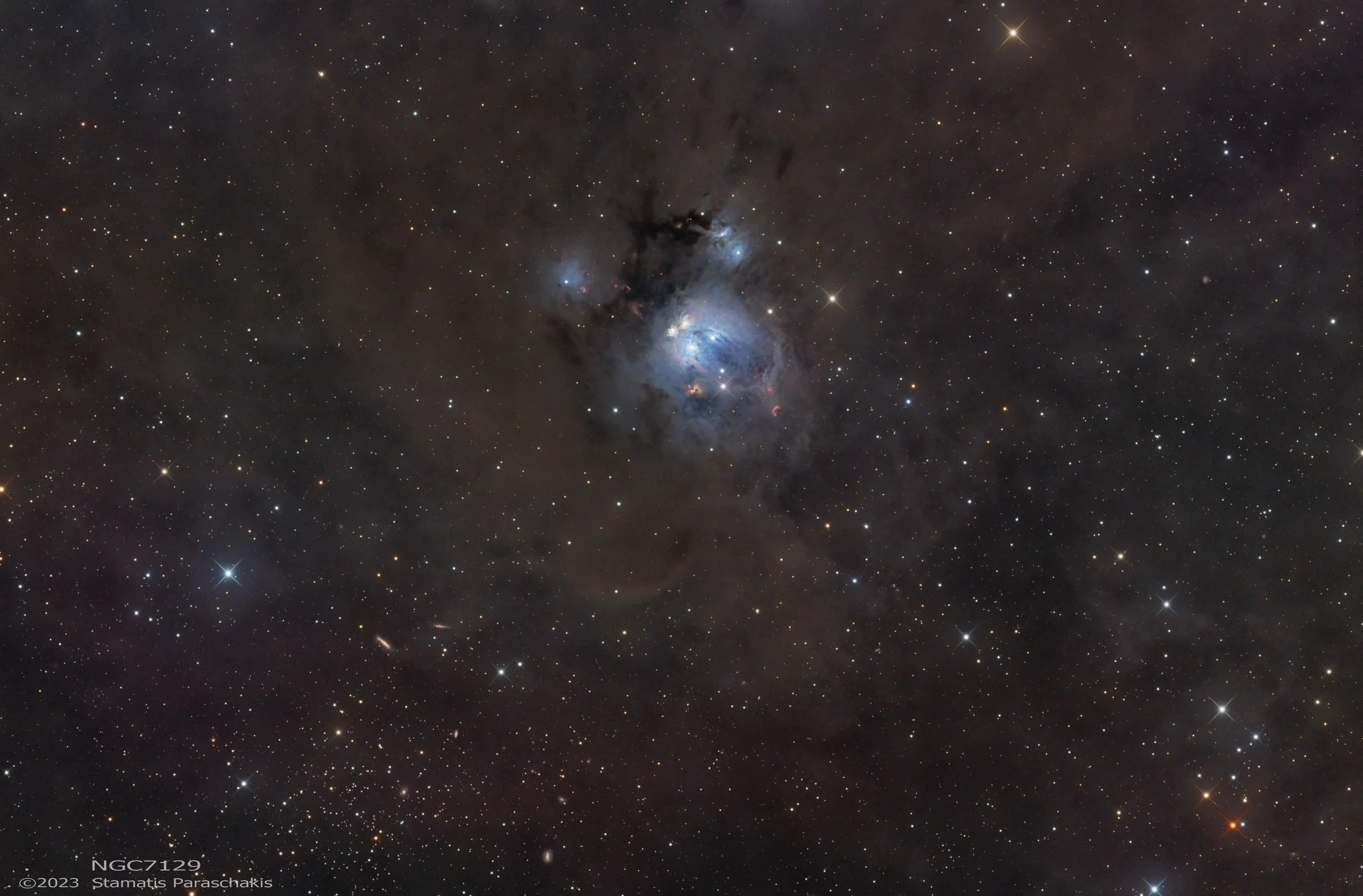
AAPOD2 Image Archives
NGC7129
NGC 7129 is a reflection nebula located in the constellation Cepheus. This stellar nursery is known for its intricate and captivating structures, which are illuminated by the light of newly formed stars within its vicinity. The nebula's striking appearance is primarily due to the scattering of starlight by fine dust particles in the interstellar medium.
NGC 7129 offers astronomers a unique opportunity to study the process of star formation and the dynamics of young stellar clusters. By examining the properties of the stars within the nebula and analyzing its molecular composition, researchers can gain insights into the conditions and mechanisms that govern the birth and evolution of stars. The study of NGC 7129 contributes to our broader understanding of the fundamental processes that shape the formation of stars and planetary systems, shedding light on the intricate interplay between radiation, matter, and gravity in the cosmos.
NGC 7129
NGC 7129 is a star forming region and reflection nebula in the constellation Cepheus. It is about 3750 light years away. The stars in this nebula are very young and only 200.000 to 3 million years old. These more than 130 young stars are responsible for illuminating the nebula. The red blobs surrounding the nebula are Herbig Haro objects, which are the result of jets of gas streaming away from the young stars in the nebula.
My current telescope is an ASA 400 16" RC (Ritchey-Chrétien) with a focal length of 3200mm (0.24"/px) on an ASA DDM 100 direct drive german equatorial mount with absolute encoders (load capacity 100kg). For imaging the night sky i use a ZWO ASI 6200 MM Pro camera with a FLI CFW2-7 filter wheel.
Copyright: Patrick Winkler
NGC 7129
Image Description and Details :
Young suns still lie within dusty NGC 7129, some 3,000 light-years away toward the royal constellation Cepheus. While these stars are at a relatively tender age, only a few million years old, it is likely that our own Sun formed in a similar stellar nursery some five billion years ago. Most noticeable in the sharp image are the lovely bluish dust clouds that reflect the youthful starlight. But the compact, deep red crescent shapes are also markers of energetic, young stellar objects. Known as Herbig-Haro objects, their shape and color is characteristic of glowing hydrogen gas shocked by jets streaming away from newborn stars. Paler, extended filaments of reddish emission mingling with the bluish clouds are caused by dust grains effectively converting the invisible ultraviolet starlight to visible red light through photoluminesence. Ultimately the natal gas and dust in the region will be dispersed, the stars drifting apart as the loose cluster orbits the center of the Galaxy.Imaging System: Planewave CDK14, Paramount ME2, FLI 16803/Chroma filtersExposure – LRGB, 15 hoursProcessing – PixinsightLocation/Date - Fort Davis, Texas / October 2021
Copyright: Good Astronomy/Steve Timmons
Rosebud Nebula - NGC 7129
The young open star cluster NGC 7129 is embedded in the bluish reflection nebula vdB 146. Due to it's shape the reflection nebula is called "Rosebud Nebula" and is located in the constellation Cepheus. The young stars have blown a large, oddly shaped bubble in the molecular cloud that once surrounded them at their birth. The rosy pink color comes from glowing dust grains on the surface of the bubble being heated by the intense light from the young stars within. Also some Herbig-Haro objects can be identified in the reflection nebula. Their shape and pinkish red color is characteristic of glowing hydrogen gas shocked by jets streaming away from newborn stars.
NGC 7142 is an open cluster about 6,200 light-years away. With an estimated age of 4.5 billion years, he is one of the oldest known open clusters.
The fine Halpha filaments on the left side of the image are part of the supernova remnant SNR 110.3 + 11.3.
Scope: ASA 10" Astrograph
Mount: ASA DDM60
Camera: Moravian G3-16200 with Astrodon LRGB and Halpha filters
Total exposure time: ~81h
Copyright: Thomas Henne





